
by Evan Spencer


by Evan Spencer
The purpose of The Compass Rose is to raise awareness of Special Collections' resources and to foster the use of these resources. The blog series also reports significant new programs, initiatives, and acquisitions of Special Collections. This week, UTA Special Collections celebrates the 60th anniversary of Arlington State College’s integration – announced on July 10, 1962 – by sharing primary sources from the University Records held in Special Collections.
UTA Special Collections collects records and information relating to the University’s history, including papers of past presidents, university offices, student organizations and publications, and more. By looking at the papers of former Arlington State College and UT-Arlington President Dr. Jack R. Woolf – who presided over the College in 1962 as it integrated – we can examine the history of integration from the university’s perspective.
Before diving into the story of integration at ASC through these documents, it is worth noting that the university’s perspective is not all-encompassing. These records document and reflect the thoughts, opinions, and decisions of those in power during the 1962 integration – those who had previously presided over a segregated College and would continue to preside over the College as it began to allow black students on campus. These records notably do not document or reflect the experiences of those Black students themselves. These students’ lack of inclusion in the university archives held at UTA Special Collections is part of a broader failure of the archival field to include and amplify the stories and voices of those often left out of the historical narrative. We at UTA Special Collections are working to address this imbalance by including diverse first-person voices and histories of Black, Indigenous, and persons of color across periods of Texas history.
NOTE: UTA Special Collections materials, including AR297 – Jack R. Woolf Papers, reflect the attitudes, ideas, and norms of the time periods and culture in which they were created. Readers should note that the following blog post contains materials that use racist and harmful language to describe persons and events. UTA Libraries seek to balance the preservation of this history with sensitivity to how these materials are presented. Materials with particularly harmful language will be noted below.
Until the 1950s, Texas’s colleges and universities were segregated by race. Arlington State College (ASC, now the University of Texas at Arlington) was no exception. Jim Crow-era laws, bolstered by court decisions, made it possible for Texas (among other states) to provide “separate but equal” educational facilities for African Americans.
On the eve of the Supreme Court’s landmark Brown v. Board of Education of Topeka decision overturning “separate but equal”, Texas had 19 publicly funded schools for white students and only 3 publicly funded schools for Black students.1 In Brown, the Supreme Court declared the doctrine of “separate but equal” unconstitutional in public schools and ordered states to end segregation “with all deliberate speed.” The Court, however, did not include instructions for how states should actually end their discriminatory practices.
In Texas, Black students pushed for integration in higher education beginning in the late 19th Century and throughout the early twentieth century. In 1950, the Supreme Court decision in Sweatt v Painter forced the University of Texas at Austin to integrate its graduate programs.2 After the Brown decision in 1954, Black students continued their push to integrate Texas’s public colleges and universities. Some carried out lawsuits – in 1956, North Texas State College became the first public college to integrate when U.S. District Judge Joe Sheehy ruled that the school could not deny admission on the basis of race3. Other schools changed their policies due to the threat of impending lawsuits from prospective Black students – Texas Tech’s board decided to integrate when threatened with a lawsuit prior to the 1961 academic year.4 According to historian Amilcar Shabazz, the 1962 desegregation of ASC and the University of Houston “signaled the true beginning of the end of Jim Crow’s stranglehold on Texas higher education.”5
In April 1962 several Black students set to graduate from James Madison High School submitted applications to Arlington State College (ASC). These applications were denied by ASC’s registrar Charles S. Nelson and forwarded to Prairie View A&M College based on existing rules within the Texas A&M System. At the time, no schools within the A&M System had integrated, and policy required that Black applicants to segregated schools be sent to the closest Black college. Prairie View, at over 230 miles away, was not a realistic option for many Dallas students who hoped to stay local for their education.
At least three of the rejected students retained Dallas attorney Fred J. Finch, Jr., chairman of the Dallas NAACP’s legal redress committee, to represent them in a potential suit against ASC.6 Finch informed ASC President Jack R. Woolf that he had been retained and wrote “I am sure it will not be necessary to resort to the courts in this matter due to the present status of the law in this regard.”
In the documents below – especially in correspondence with community members – President Woolf explained that to him and the Texas A&M Board of Directors, the central issue at hand was the “present status of the law.” Later, Woolf would explain that he viewed fighting for the continued segregation of ASC in courts to be “absolutely useless”7
After consideration of the “present status of the law”, Woolf – along with Texas A&M Chancellor M. T. Harrington – decided to change the policy of the A&M Board of Directors and allow Black students to apply and attend ASC beginning that Fall.
In September 1962, Arlington State College became the ninth public institution of higher learning in Texas to integrate (after Angelo State (1953), Midwestern State (1954), UTEP (1955), UNT (1956), Texas A&M – Kingsville (at the time, not part of the Texas A&M System, 1956), Lamar (1956), Texas Tech (1961), Texas Women’s (1961)).8 ASC was the first school in the Texas A&M System to integrate, and helped pave the way for Texas A&M and other schools in that system to integrate over the next several years.
The documents shown below are from ASC President J.R. Woolf’s papers held at UTA Special Collections. In some cases, the documents contain strong racist language and/or racially insensitive ideas. Viewer discretion is advised.
These letters, sent by ASC Registrar Charles S. Nelson, show the three-pronged approach to ASC’s response to Black applicants in April 1962. First, Nelson sent a letter to the applicant explaining that “under present regulations we are unable to admit you to Arlington State College”, and that their application would be forwarded to Prairie View A&M College. Next, Nelson sent the transcript and application to Dr. E. B. Evans, President of Prairie View. Finally, at the request of President Woolf, Nelson sent Chancellor Harrington a letter explaining the actions he had taken. In the examples below, Nelson is referring to the application of Jesse Dean Oliver.
After receiving Nelson’s explanation, Chancellor Harrington wrote him the following response.
At least three applicants, Ernest Hooper, Jerry Hanes, and Leaston Chase, hired Dallas-based NAACP attorney Fred J. Finch, Jr. to represent them in seeking admission to ASC. Finch sent this letter to inform President Woolf of his involvement on the students’ behalf.
At a regular meeting of the Board of Directors on June 29th, 1962, Harrington and the Board decided to authorize a change in admissions policy: “All races who otherwise meet the admission requirements of Arlington State College will be admitted”.
On July 10, 1962, President Woolf called a "luncheon" with local press to "ask their support in handling the release of the information in a way which would not be detrimental to the College or the students." It is unclear whether or not this luncheon would have been on or off the record. Prior to the luncheon, the topic at hand (ASC's integration) was leaked via the Fort Worth Press, apparently causing some concern among ASC’s leadership.
Woolf also sent a memo to the faculty and staff of the college explaining that he and the Board viewed the change as “the only alternate open to it rather than receive a court order to remove restrictions previously placed on admission of students”. He also asked for “the outstanding spirit of cooperation and loyalty… in facing this transition”.
After the Fort Worth Press leak, Woolf apparently decided to change plans, and convened a press conference instead of a "luncheon". Local press attended, and The Daily News-Texan reported that Woolf presented the change in policy as a proactive measure due to the “possibility of legal action.” Woolf further said, “This is a voluntary action. The only other action would have been to wait for a court order.”
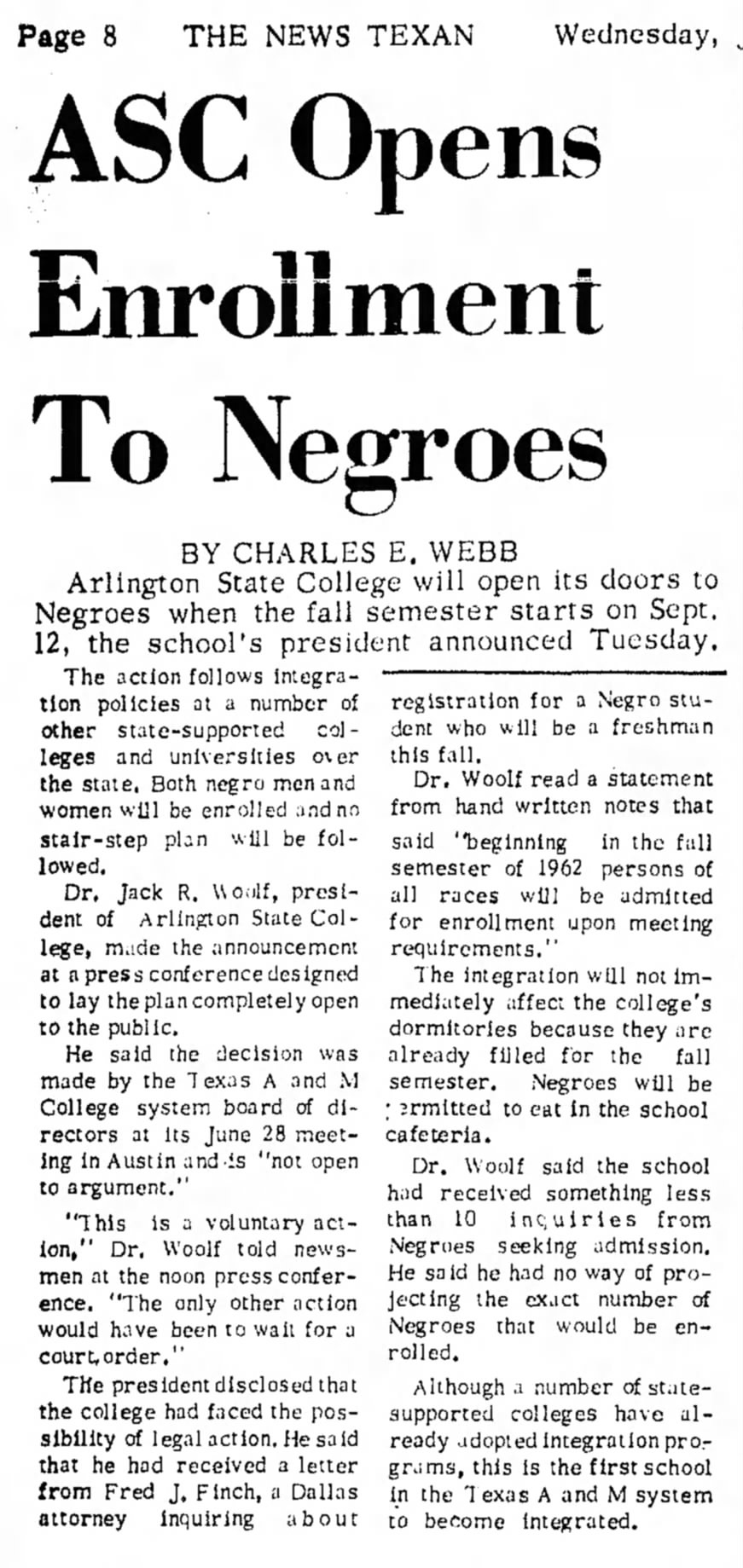
Webb, Charles E. "ASC Opens Enrollment to Negroes," Arlington Daily News-Texan, July 11, 1962.
The following day (July 11, 1962) Chancellor Harrington sent a memo to the Board of Directors explaining the Fort Worth Press leak, and telling the Board that the release “was not as President Woolf had planned.” This memo shows an early attempt by Harrington, Woolf, and Texas A&M system leadership to control the narrative around ASC's integration.
On July 18th, ASC Registrar Charles S. Nelson wrote to at least a three of the applicants to inform them that their applications had been returned from Prairie View A&M to ASC, and provided further instruction for application to the school for the fall. An example of one of these letters is below.
On July 24th, Finch sent President Woolf a letter inquiring about the status of two applicants (Herbert White Jr. and Willie B. Willis). President Woolf responded to this letter by instructing Nelson to provide a “factual letter as to what action we have taken.” Nelson, having already written the applicants in question on the 18th, sent Finch a letter explaining the situation.
After the press conference announcing ASC’s integration later that year, President Woolf’s office began responding to praise – and criticism – of the decision.
Local press, including the Daily News-Texan and Fort Worth Star-Telegram had a positive response to the press conference.

"Integration of ASC Wins Negro Attorney's Praise," Fort Worth Star-Telegram, July 11, 1962.
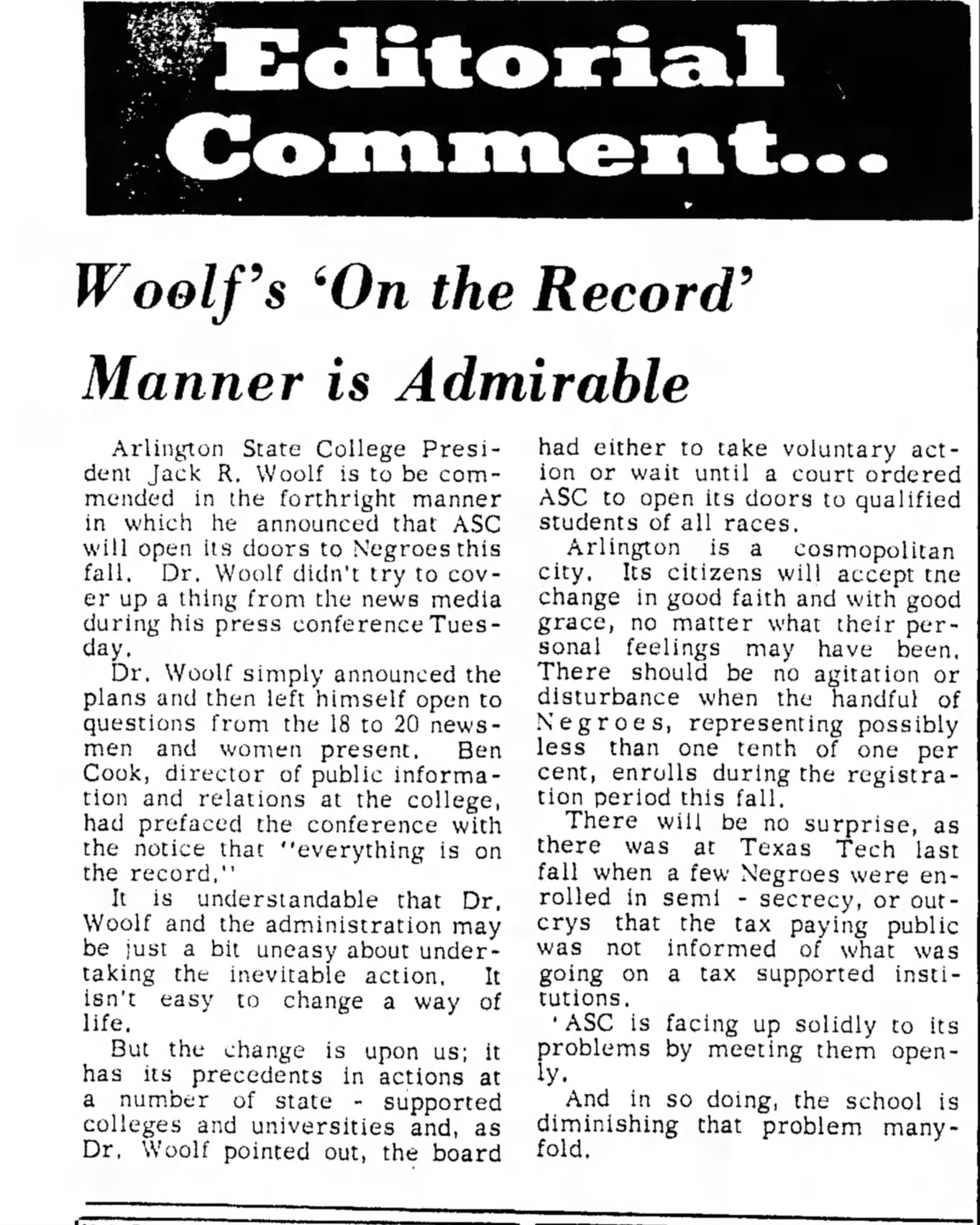
"Woolf's 'On the Record' Manner is Admirable," Arlington Daily News-Texan, July 11, 1962.
President Woolf was pleased with local coverage of the announcement and sent responses to the editor of the Daily News-Texan and the Arlington Citizen-Journal on July 16, 1962, thanking them for their “cooperation” in solving a “community problem.”
While the press reacted positively, President Woolf received several letters from racists expressing their hateful opposition to integration.
The below letters reflect the feelings and opinions of people opposed to integration – both in the Arlington community and elsewhere.
Warning: the correspondence below contains STRONG racist language. Viewer discretion is advised.
In some cases, the Woolf Papers contain carbon copies of President Woolf’s response to these letters. Below, see Woolf’s response to Daniel, Watson, and Felker, which all explain that the decision to integrate was made “with regret,” and that he and the Texas A&M Board of Directors viewed opposition in court as futile. It is unclear whether Woolf responded to the later correspondences from Stovall and Bender, as no response is attached.
At least one member of the DFW community sent President Woolf a positive response to the news that ASC would integrate.
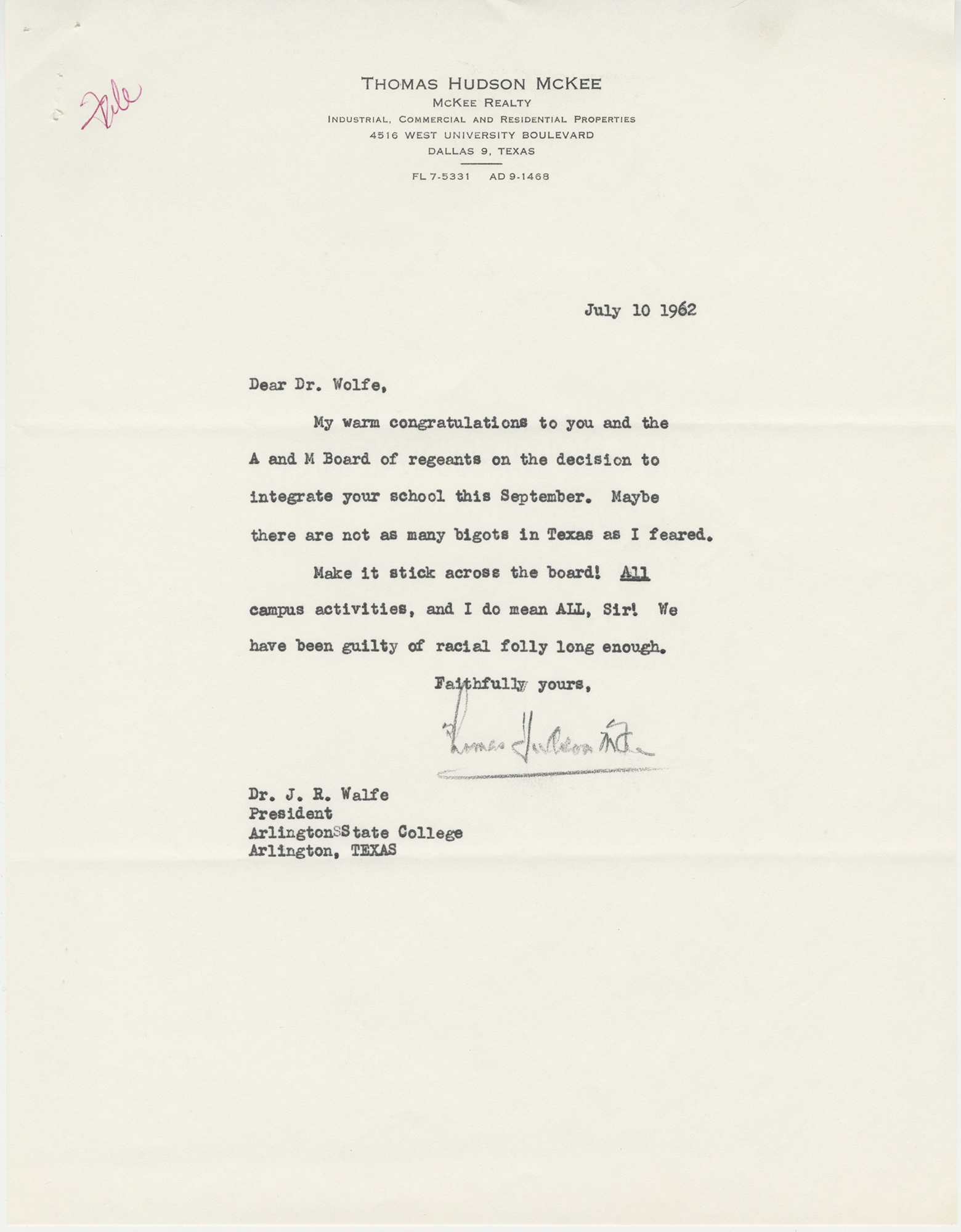
AR297, J. R. Woolf Papers, Box 4, Folder 10. July 10, 1962: Letter from Thomas Hudson McKee to ASC President J. R. Woolf, expressing support for integration.
On August 31, with the semester nearing, President Woolf sent a letter to Chancellor Harrington explaining that ASC anticipated 25 to 30 Black students enrolling for the fall semester. He also asked Harrington for guidance on how to handle the integration of housing and athletics in the future.
After their botched "luncheon" with local press, President Woolf and others at ASC continued to make conscious choices to control both the integration process and the flow of information to the press. As Black students began enrolling, the Fort Worth Star-Telegram and Daily News-Texan both reported on ASC’s integration in real time. Woolf and ASC officials, attempting to control the situation, limited access to information by not allowing press photographers inside the registrar’s office and refusing to collect or share statistics on the number of black students enrolling.
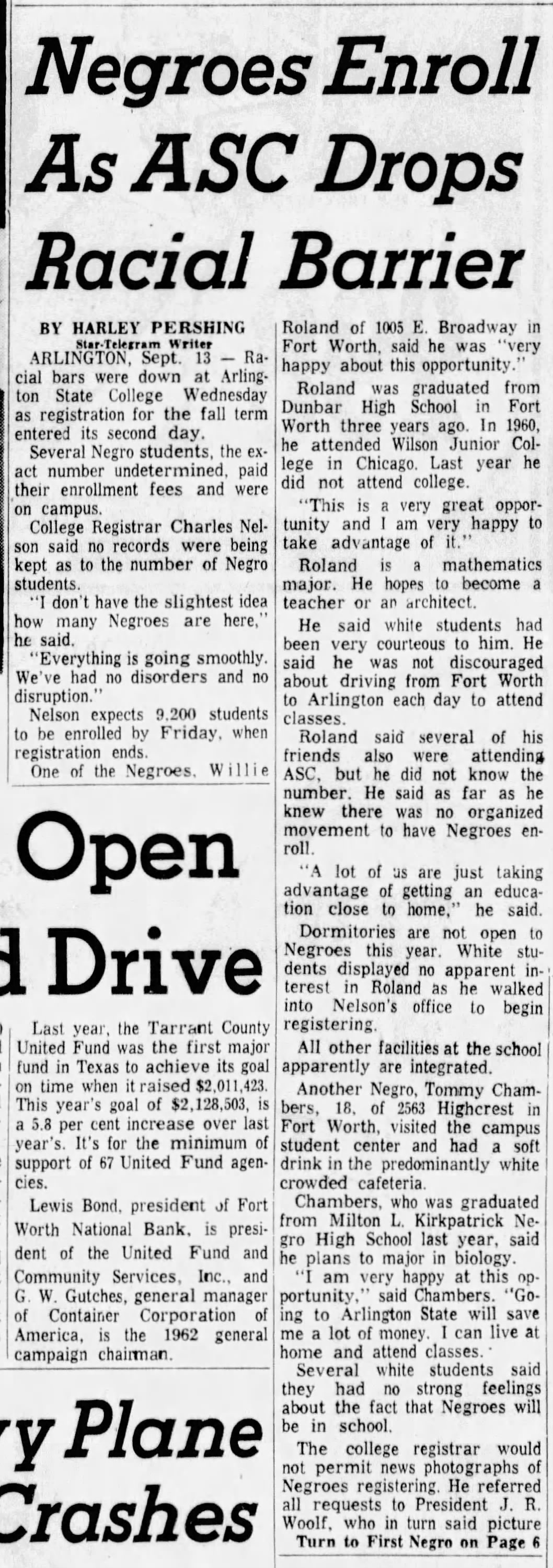
Pershing, Harley, "Negroes Enroll as ASC Drops Racial Barrier," Fort Worth Star-Telegram, September 13, 1962.

Pershing, Harley, "Negroes Enroll as ASC Drops Racial Barrier," Fort Worth Star-Telegram, September 13, 1962.
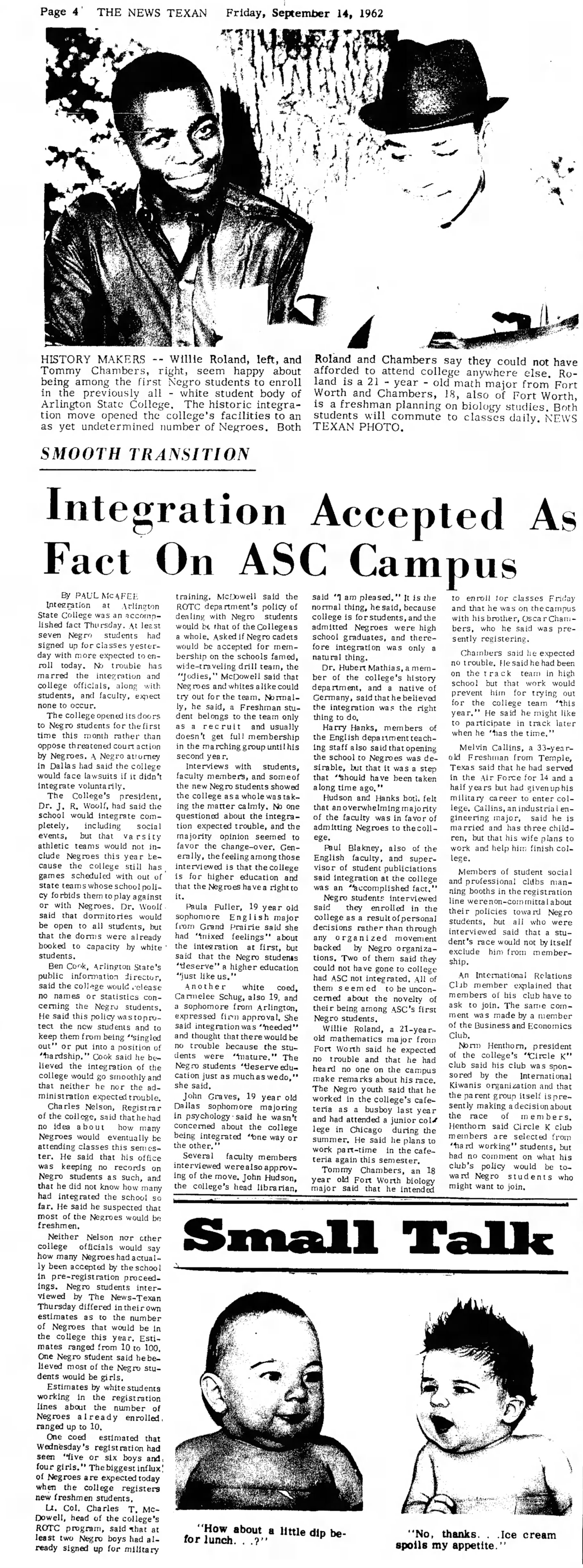
McAfee, Paul, "Integration Accepted as Fact on ASC Campus," The Daily News-Texan, September 14, 1962.

"Segregation Dies Quietly at Arlington," Fort Worth Star-Telegram, September 14, 1962.
Although Woolf, Cook, and Nelson tried to control the narrative by not allowing newswire photographers inside the registrar’s office, several Black students took the time to talk with the Star-Telegram and Daily News-Texan’s reporters. As seen above, Tommy Chambers and Willie Roland chose to allow the News-Texan’s photographer to take their picture as they made ASC’s campus their own. UTA Special Collections holds the photograph collections of the Star-Telegram, who also took a picture of Chambers as he walked on his campus for the first time as a student.
1) Texas’s 19 publicly funded schools for white students open during this era were: Houston, North Texas, UT-Arlington, UT-Austin, UT-El Paso, Texas A&M, Texas A&M-Commerce, Texas A&M-Corpus Christi, Texas A&M-Kingsville, Tarleton State, Lamar, Sam Houston State, Sul Ross State, Texas State, Angelo State, Texas Tech, Midwestern State, Stephen F. Austin, and Texas Women’s. Texas’s 3 publicly funded schools for black students were: Prairie View A&M (Prairie View), St. Philip’s College (San Antonio), and Texas Southern (Houston).
2) University of Texas at Austin Division of Diversity and Community Engagement, “The History of Integration”, accessed Jul 8, 2022, https://diversity.utexas.edu/integration/timeline/.
3) Amilcar Shabazz, Advancing Democracy: African Americans and the Struggle for Access and Equity in Higher Education in Texas (Chapel Hill, NC: UNC Press, 2004) 164-165.
4) Shabazz, Advancing Democracy, 205.
5) Shabazz, Advancing Democracy, 206.
6) J. L. Turner Legal Association Foundation, "Fred J. Finch, Esq.", accessed July 8, 2022, http://www.jlturnerfoundation.org/fred-finch--esq..html.
7) Oral History Interview of J. R. Woolf, 1994, 2009-19, Unprocessed Woolf Papers, University of Texas at Arlington Special Collections.
8) Shabazz, Advancing Democracy.
AR297 Jack R. Woolf Papers. University of Texas at Arlington Special Collections.
Saxon, Gerald D. Transitions: A Centennial History of the University of Texas at Arlington 1895 -1995. Arlington, TX: The UTA Press, 1995.
Shabazz, Amilcar. Advancing Democracy: African Americans and the Struggle for Access and Equity in Higher Education in Texas. Chapel Hill: UNC Press, 2004.
Add new comment